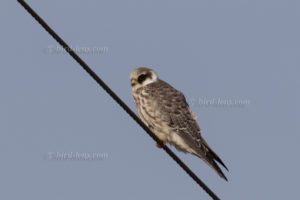 The month of August already brought the first of Red-footed Falcon (Falco vespertinus) for Germany. Maybe 2020 is a good Falcon-year again. The year 2019 at least was a strong year for the occurrence of the Red-footed Falcon.
The month of August already brought the first of Red-footed Falcon (Falco vespertinus) for Germany. Maybe 2020 is a good Falcon-year again. The year 2019 at least was a strong year for the occurrence of the Red-footed Falcon.
The Red-footed Falcon is still regarded as a vagrant from late April to early June and from August to September in Germany. However, every year some individuals are observed with a certain regularity on their fall and their spring migration.
in 2019, several Red-footed Falcons from northern Germany, especially from the northeast of the republic, were reported daily at the end of August and September.
It is well-known that the Red-footed Falcons now and then invade unusual areas. Thus in the last century mass-migration influxes through East Prussia were reported. Examples are the September 1881, May 1882, the fall of 1896 and September 1927 called.
Last year 2 Red-footed Falcons could be observed in the Niederer (Lower) Flaeming, 50km south of Berlin, too. The gentle hilly landscape of the Lower Flaming south of the medieval town of Jueterbog is agriculturally used heavily. Therefore irrigation systems and electricity pylons are already landmarks. A pumping station near Bochow is connected to the electric grid with power lines. One morning two pretty petite birds were sitting on the lines. They were already perceptible from afar. I wonder if it is small doves. A look through the spotting scope reveals that my second thought is confirmed: there are two first-year Red-footed Falcons. A quick photo was taken. However, the position of the sun drives me to do a lap so I have the sun in my back for better shots. I have to drive under the power line with the two red foot hawks. That scares them to a surprisingly short distance only. The Red-footed Falcons circle over me. A little later they land on the power lines again. One of the Red-footed Falcons flies off, sweeping over the harvested potato field at a remarkable speed, then rises and hovers. A little later the birds dives down to earth and comes up a little later with a big insect in the clutches.
Then the second bird flies over the wide plain. A little later, I suddenly see one of the red-footed hawks flying from the west about 20m above a potato field, pursued by a Eurasian Kestrel (Falco tinnunculus). The Eurasian Kestrel cannot be shaken off immediately. In any case, both birds disappear eastwards across the Meadows. Unfortunately, this way I lost track of both Red-footed Falcons.
It will be seen if more Red-footed Falcon will arrive and if a invasion will gradually end around mid-September, as in previous events
To cope with the growing demand for top shots of the rarer species of the Palearctic Bird-Lens is keen to enrich the range of pictures of birds you can find in the western Palearctic. Trips to remote places to capture images not only of rare birds of western Palearctic were very successful. The nice image of the blog is only a first impression, what you will find in the gallery in the “Picture Shop” very soon. Just give bird-lens.com a message, if bird-lens.com could serve you with an image needed before the new pictures are online.